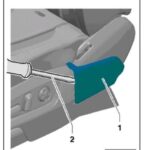It’s a familiar winter frustration: you’re rushing to your car on a chilly morning, press the unlock button on your key fob, and… nothing happens. Your key fob, which usually works like a charm, suddenly seems to have a mind of its own when the temperature drops. If you’re experiencing this head-scratching issue, you’re not alone. Many car owners find themselves wondering, “Why does my key fob not work when it’s cold?” Let’s delve into the common reasons behind this frosty fob malfunction and explore potential solutions to get you back into your car with ease, even in the depths of winter.
One of the most frequent culprits for a key fob failing in cold weather is the key fob battery. Batteries operate through chemical reactions, and these reactions slow down significantly when temperatures plummet. Think of it like this: just as your car’s engine can struggle to start in the cold due to sluggish oil and a less potent battery, the small battery in your key fob can also lose its oomph in freezing conditions. This reduced battery power might not be enough to send a strong signal to your car, especially if the battery is already nearing the end of its lifespan.
Alt text: Close-up of a car key fob, illustrating a common device that can be affected by cold weather.
Beyond the battery itself, the car’s receiver could also be sensitive to cold temperatures. The receiver is the component in your vehicle that picks up the signal from your key fob and tells the car to unlock the doors, trunk, or start the engine. Like any electronic component, the receiver can be affected by extreme temperatures. In cold weather, the receiver might become less sensitive or experience a temporary malfunction, hindering its ability to properly detect the signal from your key fob. This is less common than battery issues but still a possibility, especially in older vehicles or those with a history of electrical problems.
Another potential, though less likely, cause could be intermittent connection issues within your car’s electrical system or the key fob itself. Cold weather can sometimes exacerbate existing weak connections or cause materials to contract, leading to a temporary break in the electrical circuit. This could affect the signal path between the key fob and the car’s receiver. While temperature-related connection problems are more often associated with starting issues or other more significant electrical malfunctions, they could theoretically play a role in intermittent key fob problems in the cold.
So, what can you do when your key fob decides to take a winter break? The first and simplest step is to replace the battery in your key fob. This is often the quickest and most effective solution. Make sure to use a high-quality replacement battery of the correct type for your fob. If you’ve already replaced the battery, or if the issue persists even with a new battery, try these troubleshooting steps:
- Warm up the fob: Bring your key fob indoors and let it warm up to room temperature for a while. If the cold battery is the issue, warming it up might temporarily restore its function.
- Test in warmer conditions: If possible, park your car in a warmer location, such as a garage or in direct sunlight, and see if the key fob works then. This can help you determine if temperature is indeed the problem.
- Check other fob functions: Try using other buttons on your key fob, such as the trunk release or panic button. If some functions work while others don’t, it might indicate a specific button issue rather than a general cold-related malfunction.
- Use the physical key: As a temporary measure, you can always use the physical key inside your key fob to manually unlock your car door. This will at least get you inside your vehicle while you troubleshoot the remote issue.
Alt text: Car door handle and lock, highlighting the manual access point when key fob remotes fail in cold conditions.
If these simple fixes don’t resolve the problem, or if the issue becomes a recurring theme every winter, it’s wise to consult a professional mechanic or automotive technician. They can use specialized diagnostic tools, such as a scan tool to check for diagnostic trouble codes (DTCs). In some cases, a code like B1242 (as mentioned in the original article), might indicate a problem with the door lock receiver circuit. A professional can perform further tests on the receiver, its wiring, and related components to pinpoint the exact cause of the cold-weather key fob issue. They can also rule out other less common electrical problems that might be contributing to the malfunction.
In conclusion, while it can be frustrating when your key fob malfunctions in the cold, understanding the common reasons behind it – primarily battery performance and potentially receiver sensitivity – can help you take the right steps to diagnose and resolve the issue. Start with the simple solutions like battery replacement and temperature testing, and don’t hesitate to seek professional help if the problem persists. Staying warm and getting into your car easily, even on the coldest days, is well worth the effort.
